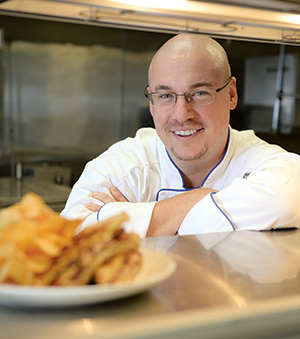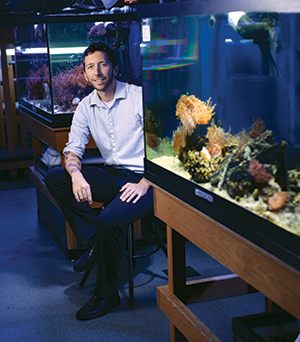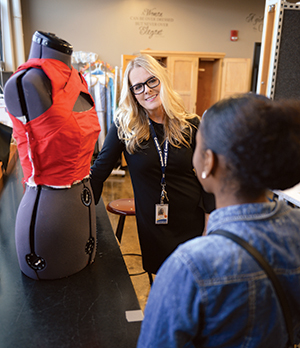Writer: Michael Morain
Photographer: Duane Tinkey
If it’s been a while since your high school days, you might be surprised by a visit to Central Campus. The career training center in the former Des Moines Technical High School, on the west edge of downtown, annually serves more than 2,000 students who bus in from high schools across Central Iowa to learn about how to design buildings, heal the sick, broadcast the news, program computers, repair cars and even fly airplanes.
In a pinch, these kids could probably rebuild civilization from scratch.
Unlike Central Academy next door, which offers Advanced Placement courses in traditional academic subjects, Central Campus offers community-college credits and even two-year associate degrees in hands-on fields that most high schools don’t cover. Many graduates head straight into lucrative jobs.
So let’s meet three instructors who teach the finer points of food, fish and fashion. And relax: There won’t be a test.
 John Andres
John Andres
Culinary Arts & Restaurant Management
While guests nibbled on salad during a recent dinner at Central Campus, a dozen students in floppy chef hats and white monogrammed jackets lined up in the kitchen to plate the main course just so: a scoop of squash, a piece of chicken, then beets, feta, tomatoes and onions, a douse of sauce, and a sprinkle of parsley.
“Not so many beets. Every single plate should be exactly the same,” chef John Andres said. “And work faster. You should have 20 plates by now.”
When two more students popped in from the dining room, he sent them right back: “Pour waters. Quickly, quickly, quickly. Go, go, go.”
He wasn’t yelling, but he meant business. And sometimes, the objectives of his business mix like oil and water. He teaches students how to cook while feeding hungry folks at school and catered events, and the student-run Central Campus Cafe (which posts its schedule on Facebook). So on nights like this, when 68 members of the Greater Des Moines Leadership Institute filled the dining room, he often has to decide whether to take a moment to explain something or just keep pushing food out the door.
“I’m a pretty laid-back guy. The students know that,” Andres says. “But once we get into this setting, they see me a little differently, like ‘Oh! He’s barking at us.’ ”
Under his leadership, the culinary program received a national award in 2016 from Advance CTE (Career Technical Education). Students can rack up credits through a partnership with Des Moines Area Community College and learn all the basics of food preparation, from safety and sanitation to grilling and baking. By the time they graduate, they’re ready to work in any kitchen in town.
“I have chefs begging me on a weekly basis to send them staff,” Andres says.
Sometimes, the students take field trips to restaurant kitchens around town and see things that wouldn’t pass muster back in their school kitchen. They’re vigilant about temperatures and the risk of cross-contamination.
“I tend to boss my parents around now when it comes to food safety,” Kathryn Post, 17, said while grilling eggplants on the school-kitchen stove. “They say, ‘Oh, it’s fine,’ but it’s very much not fine.”
Andres, 36, got his start in high school, busing tables at a nursing home in Waterloo. He came to Drake University on a violin scholarship in 1999 and worked in the kitchen at the Wakonda Club—menial stuff, mostly, until the night he subbed for a cook who didn’t show up. The work instantly appealed to him.
“The fact that they were creating something, that it was fast-paced, that it was done on the fly—I thought that was pretty cool,” he says.
So he switched majors at Drake, from music to business, then headed to the Culinary Institute of America in Hyde Park, N.Y. Afterward, he returned to the Wakonda Club, this time as a sous chef, and soon moved downtown to the Savery, where he worked 80-hour weeks as the executive chef and beverage director.
He didn’t sleep much. He slept even less when he and his wife, Jennifer, welcomed their daughter, Addy, in 2013. A son, Charlie, came into the picture a year later.
But now, five years into his job at Central, Andres feels like he’s landed at the right spot. He cooks at home again, for the fun of it, and enjoys his summers off.
The other night, after students gobbled up the leftover dessert—strawberry-rhubarb crisp—several ducked into Andres’ office with questions about work. A staffer stopped in, too, to thank him for the tacos his students had served to teachers before some evening meetings.
The school’s director, Aiddy Phomvisay, brought in a big bucket of tips from the dinner guests and grinned as he said, “I told them it was optional.”
 Greg Barord
Greg Barord
Marine Biology
Students in Greg Barord’s marine biology class aren’t kidding when they call it hands-on. But, technically, it’s hands-in.
They were elbows-deep in the glowing aquariums recently when “Dr. B” announced a few changes to the “squeegee protocols.” That meant new rules for more than 100 tanks and the 150-some kinds of creatures that live inside them, including jellyfish, stingrays and bright yellow seahorses. Students in marine biology and Kirk Embree’s aquarium science program manage all the daily tasks that make this facility in the middle of the Midwest the envy of high schools nationwide.
Their immersive education includes applying for grants, writing articles for academic journals and taking field trips to Texas, California, Oregon and Washington. A group will fly this spring to Miami and work their way up the Florida coast, collecting data to help in the wake of hurricanes Harvey, Irma and Maria.
“If you don’t have these opportunities, how do you know how far you can succeed?” Barord, 34, says in a classroom filled with specimens you can’t find in any Iowa river or pond.
After class one day last fall, a lanky East High School sophomore named Andrew Lamb came back to grab his bag and, with some prompting from his teacher, performed a little dance the class had learned that day. He stuck out one arm to represent water and the other to represent wind and then did a 360 turn to show how currents can swirl into a vortex.
“Dr. B keeps you focused,” Lamb said. “He keeps you awake in class.”
On this particular day, Dr. B wore shorts, so you could see the tattooed squid that wraps its red and black tentacles around his right calf. The real one he saw in a documentary when he was age 4 grabbed his imagination and never let go.
He studied marine biology in Texas, where he was born, and recalled what a professor announced on the first day of class: “If you’re here to train dolphins, you can leave right now.”
But that was fine with Barord, who found other ways to get his feet wet. He worked for a while in Galveston, Texas, and did a stint in Alaska for the federal government.
In 2014, he was five years into a doctoral program at Brooklyn College, in New York, when he started teaching at Central Campus and polished off his dissertation. A copy of it now sits on his desk, bound in black and embossed with gold letters: “On the Biology, Behavior and Conservation of the Chambered Nautilus.”
Barord was at a conference in 2006 when he learned about the animal’s plunging population. After half a billion years on earth, the spiral-shelled cousin of the squid and octopus is disappearing in alarming numbers due to overfishing in its habitat, deep in the South Pacific.
Barord’s fascination with the species and concern for its survival has guided his career, and he has more tattoos to prove it. On one arm: a nautilus with a tracking device. On the other: a treasure chest overflowing with coins from Fiji, Samoa, Palau and other places where he’s conducted research. In 2016 he traveled to South Africa for a conference to add the nautilus to the list of endangered species.
He arranged for five nautiluses to be flown to Central Campus from the Philippines in 2014. When U.S. Customs held them up in Chicago, he drove overnight to pick them up at the Shedd Aquarium and returned to Des Moines the next morning to teach class.
Two more arrived later, but, sadly, all seven died last year when a pump malfunctioned. A student discovered the problem during a routine inspection, but it was too late.
Barord hopes to receive a few more this winter, but the process is tougher now, thanks to rules he helped write.
It’s been a hard lesson for his students and a reminder that some resources aren’t endless. Last semester, Barord quietly removed chairs one by one from his classroom until students found themselves sitting on tables or the floor. They even moved class to another room until the day Dr. B showed them a documentary about rising sea levels and an island in Papua New Guinea that will soon disappear.
The lesson sank in.
“We can’t do everything, but little things make a big impact,” he says. “I’m trying to do everything I can to get them to think.”
 Tracy Holland
Tracy Holland
Fashion Design & Merchandising
A few years ago, so many people went online to see photos from the annual Central Campus fashion show that the school district’s computer system crashed.
A district official called the show’s director, Tracy Holland, with a message of blame and praise: “I just want you to know the server is down, and you did it.”
It was one of the best calls of Holland’s 19 years at the school, where she presides over a buzzing hive of sewing machines and student creativity. During her tenure, she’s expanded the fashion program’s college credits from four to 21 and regularly sends graduates to fashion jobs across the country.
“I work with the greatest kids you’ll ever meet,” she says. “It’s so, so satisfying and humbling when a student looks at you and says, ‘I made this—I made this—and someone wants to buy it.’ ”
For Holland, 50, it all started when a third-grade classmate at her east-side elementary school brought in some puppets for a puppet show. She resolved to make some of her own.
From there, she started making clothes for her dolls and then for herself. She spent her summers biking to a fabric store on Hubbell Avenue and returning with material to keep herself busy. At East High School, she would often spot a skirt or shirt in a magazine, make it that night, and wear it the next day.
She graduated with honors from Bauder Fashion College in Dallas in 1988. For the next two years, she worked as a buyer for Younkers, here in Des Moines, and she spent three years traveling the Midwest for Liz Claiborne.
She stayed home in the mid-’90s to raise three kids, including two daughters who got to wear some of the best dance-recital costumes in town.
After Holland gave a talk during a career fair at East High, one thing led to another. She started teaching part time at Central Campus in 1998, and eventually overhauled the entire fashion program to better prepare students for the industry. She picked up a business degree from William Penn University in order to offer her students more college credits.
Students in Holland’s workshop learn how to dissect a garment and rebuild it, stitch by stitch. She challenges them to figure things out on their own, but these days—“when they’re born with two arms, two legs and a cellphone”—she lets them record her demonstrations for reference. Sometimes she’ll walk around the studio and hear recordings of her own voice chatting away in every corner.
“She’s like a mom and an aunt and a cool best friend all at once,” says Jordan George, a 17-year-old from Roosevelt. “She’s fun and engaging, but we still know when we need to grind things out and stay on deadline.”
Once students learn the basics, they apply their skills to all sorts of assignments, from supervillain costumes to the classic little black dress. They make things out of bubble wrap for the Bubble Ball, an annual fundraiser for ChildServe, and design hospital gowns for teens with cancer.
“We were doing challenges before ‘Project Runway’ was ever on TV,” Holland says.
Everything leads up to the spring fashion show, which this year lands on April 26 and will borrow talent from many other programs at the school. Graphic design students make posters. Culinary students feed models and tech crew during rehearsals. Photography students shoot the photos that may or may not crash the district’s computers.
The scale of the event usually surprises newcomers. It’s big and loud and edgy.
“It appeals to kids, but it’s a class act,” Holland says. “I always tell my kids that Grandma is in the audience. We wear Spanx so everything is covered.”
And really, that about covers it. After two years in Holland’s workshop, students can make just about anything—if they keep at it.
“I tell parents all the time: ‘Feed their creativity,’ ” Holland says. “If they finish a project, tell them to start another.”











